Guest Blogged by John Gideon and Ellen Theisen, VotersUnite.Org
 There can be little doubt that, of the issues springing from elections held since George W. Bush signed the Help America Vote Act (HAVA) of 2002, two are among the most significant. Those issues are failures of voting systems to meet the HAVA mandates for accuracy and accessibility and the confusion over the proper use of provisional ballots.
There can be little doubt that, of the issues springing from elections held since George W. Bush signed the Help America Vote Act (HAVA) of 2002, two are among the most significant. Those issues are failures of voting systems to meet the HAVA mandates for accuracy and accessibility and the confusion over the proper use of provisional ballots.
The states should have been able to look to the federal Election Assistance Commission (EAC) for guidance on both issues, but the EAC has failed to give the necessary Assistance, thus failing to fulfill duties assigned to the agency by federal law.
Now the EAC is proposing to extend its dereliction of duty for another two years. The result will be the publication of these important guidelines a full eight years after HAVA was enacted. The delay is inexcusable and intolerable, and the cost to American elections, on many fronts, is nearly incalculable...
HAVA requires the EAC to provide such guidance to the states, as Section 311 states:
(b) Deadlines.--The Commission shall adopt the recommendations under this section not later than--
- (1) in the case of the recommendations with respect to section 301, January 1, 2004; [voting system requirements]
- (2) in the case of the recommendations with respect to section 302, October 1, 2003; [provisional voting] and
- (3) in the case of the recommendations with respect to section 303, October 1, 2003. [computerized voter registration lists]
(c) Quadrennial Update.--The Commission shall review and update recommendations adopted with respect to section 301 no less frequently than once every 4 years.
And Section 312 goes on to mandate:
- (1) Publication of notice of the proposed recommendations in the Federal Register.
- (2) An opportunity for public comment on the proposed recommendations.
- (3) An opportunity for a public hearing on the record.
- (4) Publication of the final recommendations in the Federal Register.
In a recent email to the EAC spokeswoman, Jeannie Layson, we asked about the guidance the EAC was required to provide several years ago. In the email we asked:
Also I note that in the draft "Strategic Plan" there is mention of HAVA Section III. Goal 3, Objective 3 is, in part, to provide guidance to states concerning the proper implementation of the HAVA Title III requirements. Isn't this objective actually the requirement from Sec. 311 of HAVA?
Layson responded that, in fact, the EAC had not issued any voluntary guidance on either Section 301 (voting systems) or Section 302 (provisional ballots). She correctly pointed to several advisories that had been published by the EAC, however.
She wrote in her response:
Per your question, we have not issued guidance on those topics, but we have issued several advisories, which are available here. As you noted, the EAC's draft strategic plan states that we will issue all of the Title III guidance by Oct. 2010. Go here to view the draft strategic plan. And don't forget that we are seeking public comment on the plan, so if you have suggestions/criticisms/etc. please submit them. As soon as the public comment notice is published in the Federal Register notice, we'll provide instructions and the dates to submit comments. Please let me know if you need further assistance.
It is troubling that a federal commission assigned by Congress to give guidance to states concerning the use of voting systems and provisional ballots has been so long delinquent on that vital assignment. Not only has the EAC failed to meet the mandated deadlines of 1 January 2004 (Section 301) and 1 January 2003 (Section 302), but the Commission has also failed to meet the requirements for quadrennial updates of the guidance.
In its “Strategic Plan”, the EAC claims to be committed to “Timely performance of its duties”. Clearly the EAC has failed to meet this commitment.
By ignoring its mandate to provide guidance on provisional ballot usage, the EAC has allowed some states and local jurisdictions to misuse a system that was supposed to allow more voters to vote and have their votes counted. Instead we have heard many reports of election officials not even looking at provisional ballots because they decided that “counting the provisional ballots would not result in any changes in any races.” Clearly, the states have needed guidance, yet the EAC has remained silent.
By its negligence, the EAC has allowed private voting system vendors -– with an undisputed conflict of interest -– to become the de facto authorities on determining whether their own equipment is HAVA compliant. As a result, the states have poured billions of taxpayer dollars into inaccessible, unreliable, inaccurate equipment in a misguided attempt to avoid violating federal law. Voters have paid for equipment that has been shown to lose their votes or count their votes inaccurately. Voters with disabilities have paid for equipment on which they cannot vote independently and privately.
For example, many jurisdictions use ES&S iVotronic Direct Recording Electronic (DRE/touch-screen) voting machines to meet the accessibility requirement of HAVA. Yet when Hawaii was in the process of selecting a voting system to be used by the state, the evaluation team devalued the ES&S iVotronic for its failure to provide accessibility to people with disabilities.
Judy Paik, one member of Hawaii's voting system evaluation team wrote in her report:
The controls on the iVotronic are not accessible for someone who has a physical impairment that limits their dexterity to manipulate or press buttons and touch a small target area on the screen. No attachments are available to allow such voters to use a closed fist, palm of the hand, elbow or even a foot to operate the iVotronic to cast their ballot.
As California’s Top-to-Bottom-Review of the state's electronic voting systems and other reports show, equipment made by the other vendors also falls short of meeting HAVA’s accessibility requirement.
During these recent years of conflict over voting systems and how they are tested, certified, and used and whether they actually meet the federal voluntary voting system standards and the requirements mandated by HAVA, no guidance has been provided by the one agency that is supposed to provide that guidance. Instead, by ignoring Section 311 and 312 of HAVA, the EAC has been silent while the voting machine vendors sold their wares as being compliant with HAVA --- a claim that report after report shows to be untrue.
Now the Commissioners have decided that they need to comply with HAVA, so they have added an “Objective” into their “Strategic Plan” for 2009 to 2014, and the stated goal is to have some type of guidance to the states by 1 Oct. 2010 –- seven years after the states needed that guidance. By then –- as it is now –- most of the money appropriated for HAVA will have been spent on systems that do not comply with the law. By then –- as it is now -– most states will be resistant to guidance that may lead to new expenses and new election procedures. By then, secretaries of state, private institutions, and private citizens will have done more to complete the job which, by the EAC’s silence, they have left undone, and the Commissioners’ guidance may be then -– as it may be already –- too little and too late.
The EAC’s refusal to comply with HAVA’s mandate to provide Assistance to the states has had enormous negative repercussions in the real world of American elections. Surely with the financial resources at their disposal from the taxpayers, the information available in reports from election officials across the country, as well as the National Institute of Standards and Technology (NIST), and the expertise available to them pro bono from the election integrity community, they should be able to provide some valuable guidance sooner than two years from now, a full eight years after the federal law was enacted.


 Vets Push Back at Trump, Musk Plan to Slash Health Care, 80K V.A. Jobs: 'BradCast' 3/27/25
Vets Push Back at Trump, Musk Plan to Slash Health Care, 80K V.A. Jobs: 'BradCast' 3/27/25 'Green News Report' 3/27/25
'Green News Report' 3/27/25
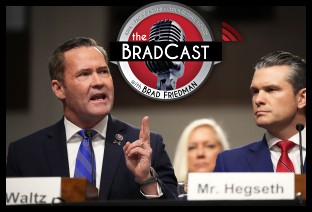 Signal Scandal Worsens for Trump, GOP; Big Election Victories for Dems in PA: 'BradCast' 3/26/25
Signal Scandal Worsens for Trump, GOP; Big Election Victories for Dems in PA: 'BradCast' 3/26/25 'Emptywheel' on Why Trump NatSec Team Should 'Resign in Disgrace' After Signal Chat Debacle: 'BradCast' 3/25/25
'Emptywheel' on Why Trump NatSec Team Should 'Resign in Disgrace' After Signal Chat Debacle: 'BradCast' 3/25/25 'Green News Report' 3/25/25
'Green News Report' 3/25/25 Postal Workers Union Prez: USPS 'Belongs to the People, Not the Billionaires':
Postal Workers Union Prez: USPS 'Belongs to the People, Not the Billionaires':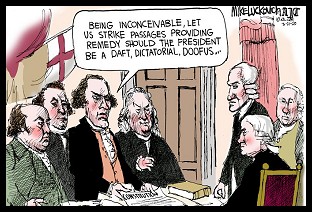 Sunday 'Suddenly Conceivable' Toons
Sunday 'Suddenly Conceivable' Toons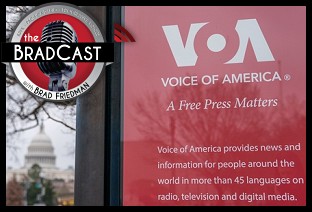 We're ALL Voice of America Now: 'BradCast' 3/20/25
We're ALL Voice of America Now: 'BradCast' 3/20/25 'Green News Report' 3/20/25
'Green News Report' 3/20/25 What Trump's 'Timber Production Expansion' Means (and Costs): 'BradCast' 3/19/25
What Trump's 'Timber Production Expansion' Means (and Costs): 'BradCast' 3/19/25 Courts Largely Holding Against Trump, Musk Lawlessness: 'BradCast' 3/18/25
Courts Largely Holding Against Trump, Musk Lawlessness: 'BradCast' 3/18/25 'Green News Report' 3/18/25
'Green News Report' 3/18/25 Chief VOA Reporter on Outlet Falling Silent First Time Since 1942: 'BradCast' 3/17/25
Chief VOA Reporter on Outlet Falling Silent First Time Since 1942: 'BradCast' 3/17/25 Sunday 'The Usual' Toons
Sunday 'The Usual' Toons 'Green News Report' 3/13/25
'Green News Report' 3/13/25 Trump EPA Unveils Plans to Endanger, Sicken Americans: 'BradCast' 3/13/25
Trump EPA Unveils Plans to Endanger, Sicken Americans: 'BradCast' 3/13/25 Trump Nixed Enforce-ment Against 100 Corp. Lawbreakers: 'BradCast' 3/12/25
Trump Nixed Enforce-ment Against 100 Corp. Lawbreakers: 'BradCast' 3/12/25 Bad Day for 'Strongmen': 'BradCast' 3/11
Bad Day for 'Strongmen': 'BradCast' 3/11 WI Election Could Flip Supreme Court Control, Musk Jumps In: 'BradCast' 3/10
WI Election Could Flip Supreme Court Control, Musk Jumps In: 'BradCast' 3/10 'What Else Could a Russian Asset Do That Trump Hasn't?': 'BradCast' 3/6/25
'What Else Could a Russian Asset Do That Trump Hasn't?': 'BradCast' 3/6/25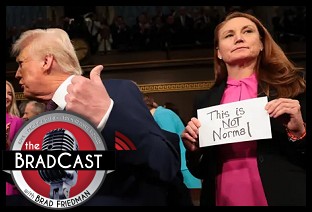 The Longest, Dullest, Most Lie-Filled 'SOTU' Ever: 'BradCast' 3/5/25
The Longest, Dullest, Most Lie-Filled 'SOTU' Ever: 'BradCast' 3/5/25 Trump Bad for Biz... and Farmers... and Nat'l Parks... and...: 'BradCast' 3/4/25
Trump Bad for Biz... and Farmers... and Nat'l Parks... and...: 'BradCast' 3/4/25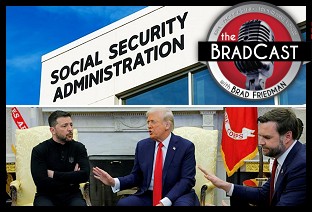 Trump Targeting 50% Cuts, Office Closures at Social Security: 'BradCast' 3/3/25
Trump Targeting 50% Cuts, Office Closures at Social Security: 'BradCast' 3/3/25
 VA GOP VOTER REG FRAUDSTER OFF HOOK
VA GOP VOTER REG FRAUDSTER OFF HOOK Criminal GOP Voter Registration Fraud Probe Expanding in VA
Criminal GOP Voter Registration Fraud Probe Expanding in VA DOJ PROBE SOUGHT AFTER VA ARREST
DOJ PROBE SOUGHT AFTER VA ARREST Arrest in VA: GOP Voter Reg Scandal Widens
Arrest in VA: GOP Voter Reg Scandal Widens ALL TOGETHER: ROVE, SPROUL, KOCHS, RNC
ALL TOGETHER: ROVE, SPROUL, KOCHS, RNC LATimes: RNC's 'Fired' Sproul Working for Repubs in 'as Many as 30 States'
LATimes: RNC's 'Fired' Sproul Working for Repubs in 'as Many as 30 States' 'Fired' Sproul Group 'Cloned', Still Working for Republicans in At Least 10 States
'Fired' Sproul Group 'Cloned', Still Working for Republicans in At Least 10 States FINALLY: FOX ON GOP REG FRAUD SCANDAL
FINALLY: FOX ON GOP REG FRAUD SCANDAL COLORADO FOLLOWS FLORIDA WITH GOP CRIMINAL INVESTIGATION
COLORADO FOLLOWS FLORIDA WITH GOP CRIMINAL INVESTIGATION CRIMINAL PROBE LAUNCHED INTO GOP VOTER REGISTRATION FRAUD SCANDAL IN FL
CRIMINAL PROBE LAUNCHED INTO GOP VOTER REGISTRATION FRAUD SCANDAL IN FL Brad Breaks PA Photo ID & GOP Registration Fraud Scandal News on Hartmann TV
Brad Breaks PA Photo ID & GOP Registration Fraud Scandal News on Hartmann TV  CAUGHT ON TAPE: COORDINATED NATIONWIDE GOP VOTER REG SCAM
CAUGHT ON TAPE: COORDINATED NATIONWIDE GOP VOTER REG SCAM CRIMINAL ELECTION FRAUD COMPLAINT FILED AGAINST GOP 'FRAUD' FIRM
CRIMINAL ELECTION FRAUD COMPLAINT FILED AGAINST GOP 'FRAUD' FIRM RICK SCOTT GETS ROLLED IN GOP REGISTRATION FRAUD SCANDAL
RICK SCOTT GETS ROLLED IN GOP REGISTRATION FRAUD SCANDAL VIDEO: Brad Breaks GOP Reg Fraud Scandal on Hartmann TV
VIDEO: Brad Breaks GOP Reg Fraud Scandal on Hartmann TV RNC FIRES NATIONAL VOTER REGISTRATION FIRM FOR FRAUD
RNC FIRES NATIONAL VOTER REGISTRATION FIRM FOR FRAUD EXCLUSIVE: Intvw w/ FL Official Who First Discovered GOP Reg Fraud
EXCLUSIVE: Intvw w/ FL Official Who First Discovered GOP Reg Fraud GOP REGISTRATION FRAUD FOUND IN FL
GOP REGISTRATION FRAUD FOUND IN FL


































